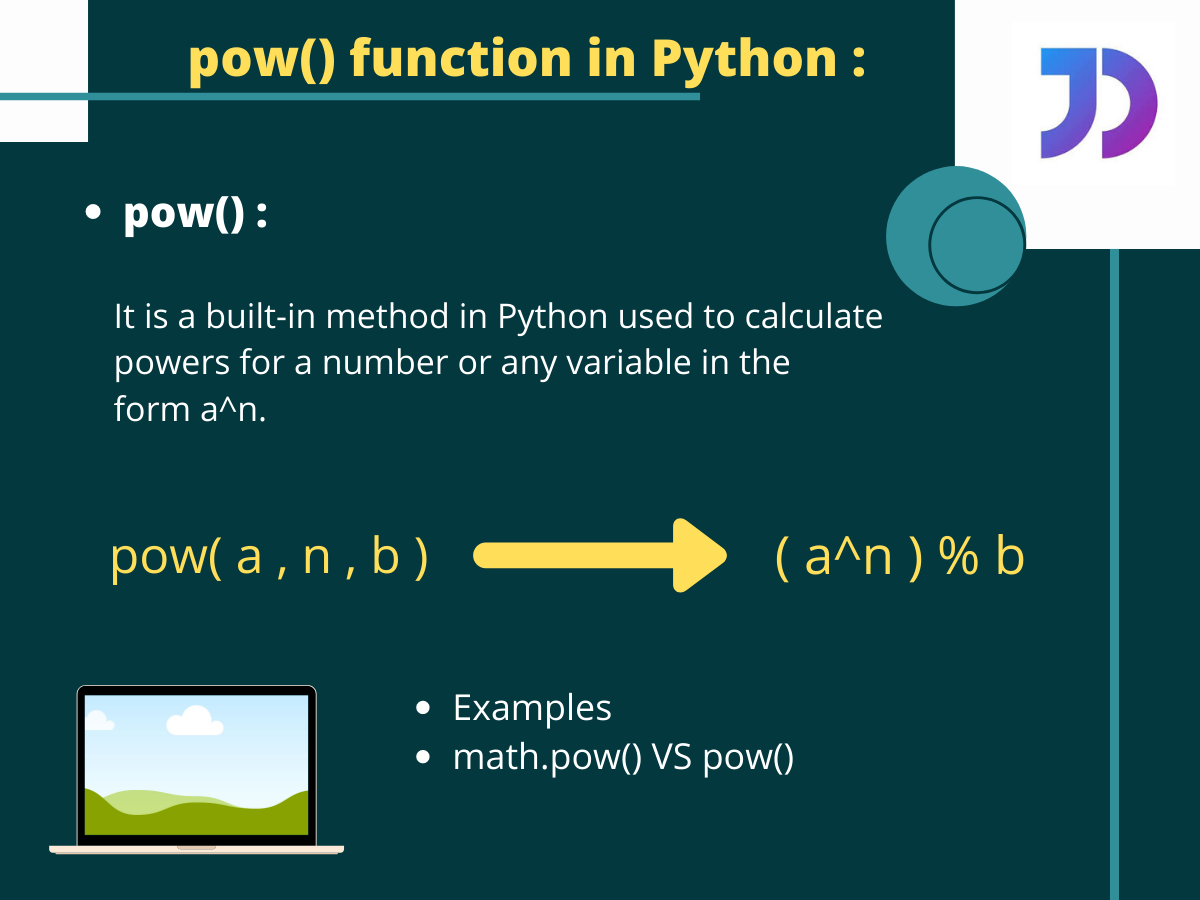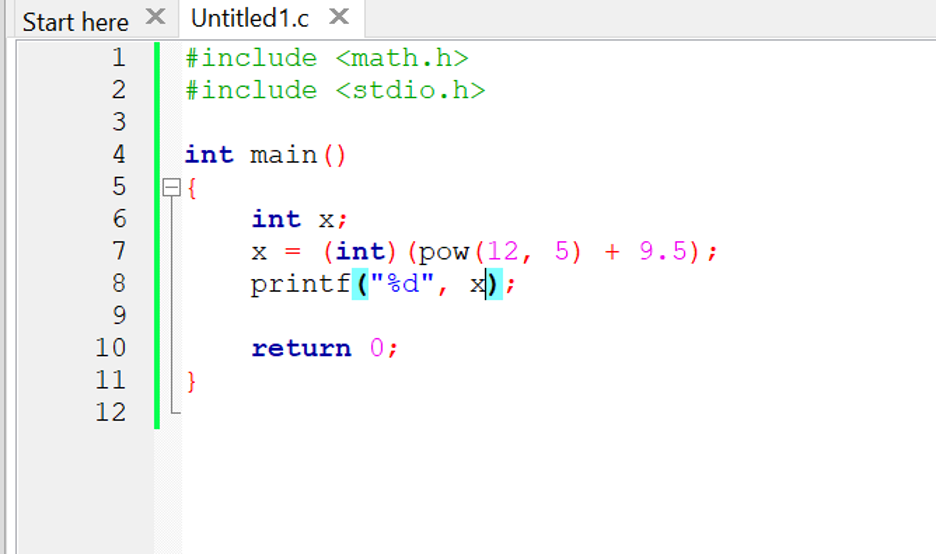C Math Pow
C Math Pow - This function allows programmers to calculate a base number raised. The pow() function is defined in the <math.h> header file. A domain error occurs if x is finite and negative and y is finite and not an integer value. Basically in c/c++, the exponent value is calculated using the. The pow() function raises a number to the power of another number. The pow() function takes two arguments (base value and power value) and, returns the power raised to the base number. For example, [mathematics] x y = pow(x, y) [in programming]. The c library pow() function of type double accepts the parameter x and y that simplifies the x raised to the power of y. Given two numbers base and exponent, the c++ or c pow() function finds x raised to the power of y i.e. The c standard (n1548 §7.12.7.4) has this to say about pow:
The pow() function raises a number to the power of another number. For example, [mathematics] x y = pow(x, y) [in programming]. So, according to the c standard,. Given two numbers base and exponent, the c++ or c pow() function finds x raised to the power of y i.e. Basically in c/c++, the exponent value is calculated using the. This function allows programmers to calculate a base number raised. The c library pow() function of type double accepts the parameter x and y that simplifies the x raised to the power of y. The pow() function is defined in the <math.h> header file. The c standard (n1548 §7.12.7.4) has this to say about pow: A domain error occurs if x is finite and negative and y is finite and not an integer value.
For example, [mathematics] x y = pow(x, y) [in programming]. The c standard (n1548 §7.12.7.4) has this to say about pow: The c library pow() function of type double accepts the parameter x and y that simplifies the x raised to the power of y. A domain error occurs if x is finite and negative and y is finite and not an integer value. Basically in c/c++, the exponent value is calculated using the. The pow() function raises a number to the power of another number. Given two numbers base and exponent, the c++ or c pow() function finds x raised to the power of y i.e. This function allows programmers to calculate a base number raised. So, according to the c standard,. The pow() function takes two arguments (base value and power value) and, returns the power raised to the base number.
pow Math function in C Programming Language Video Tutorial YouTube
The pow() function raises a number to the power of another number. The c library pow() function of type double accepts the parameter x and y that simplifies the x raised to the power of y. A domain error occurs if x is finite and negative and y is finite and not an integer value. Basically in c/c++, the exponent.
C Tutorial C Math Pow
A domain error occurs if x is finite and negative and y is finite and not an integer value. The pow() function takes two arguments (base value and power value) and, returns the power raised to the base number. This function allows programmers to calculate a base number raised. For example, [mathematics] x y = pow(x, y) [in programming]. Basically.
Python pow() method AskPython
This function allows programmers to calculate a base number raised. The pow() function takes two arguments (base value and power value) and, returns the power raised to the base number. For example, [mathematics] x y = pow(x, y) [in programming]. So, according to the c standard,. Basically in c/c++, the exponent value is calculated using the.
pow() function C Programming Tutorial YouTube
A domain error occurs if x is finite and negative and y is finite and not an integer value. The c standard (n1548 §7.12.7.4) has this to say about pow: The pow() function raises a number to the power of another number. Given two numbers base and exponent, the c++ or c pow() function finds x raised to the power.
今日打开第一题小题大做了CSDN社区
The c library pow() function of type double accepts the parameter x and y that simplifies the x raised to the power of y. The pow() function takes two arguments (base value and power value) and, returns the power raised to the base number. This function allows programmers to calculate a base number raised. For example, [mathematics] x y =.
Java Math.pow函数。完整指南Math.pow() 用于计算一个数字上升到另一个数字的幂。pow()方法在考虑 掘金
A domain error occurs if x is finite and negative and y is finite and not an integer value. The c standard (n1548 §7.12.7.4) has this to say about pow: Given two numbers base and exponent, the c++ or c pow() function finds x raised to the power of y i.e. Basically in c/c++, the exponent value is calculated using.
Pow Function in C
Given two numbers base and exponent, the c++ or c pow() function finds x raised to the power of y i.e. Basically in c/c++, the exponent value is calculated using the. So, according to the c standard,. For example, [mathematics] x y = pow(x, y) [in programming]. The pow() function is defined in the <math.h> header file.
C Programming Tutorial 10 The pow() Function YouTube
The pow() function takes two arguments (base value and power value) and, returns the power raised to the base number. For example, [mathematics] x y = pow(x, y) [in programming]. Basically in c/c++, the exponent value is calculated using the. The pow() function is defined in the <math.h> header file. So, according to the c standard,.
math.h in c++ pow function YouTube
The pow() function raises a number to the power of another number. The pow() function is defined in the <math.h> header file. So, according to the c standard,. The c standard (n1548 §7.12.7.4) has this to say about pow: This function allows programmers to calculate a base number raised.
POW FUNCTION C++ YouTube
The c library pow() function of type double accepts the parameter x and y that simplifies the x raised to the power of y. The pow() function is defined in the <math.h> header file. Basically in c/c++, the exponent value is calculated using the. So, according to the c standard,. The pow() function raises a number to the power of.
The Pow() Function Takes Two Arguments (Base Value And Power Value) And, Returns The Power Raised To The Base Number.
The c standard (n1548 §7.12.7.4) has this to say about pow: The c library pow() function of type double accepts the parameter x and y that simplifies the x raised to the power of y. This function allows programmers to calculate a base number raised. Basically in c/c++, the exponent value is calculated using the.
A Domain Error Occurs If X Is Finite And Negative And Y Is Finite And Not An Integer Value.
Given two numbers base and exponent, the c++ or c pow() function finds x raised to the power of y i.e. The pow() function raises a number to the power of another number. For example, [mathematics] x y = pow(x, y) [in programming]. So, according to the c standard,.







